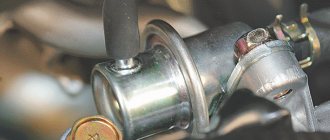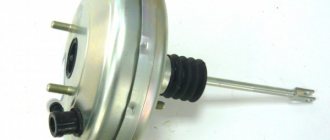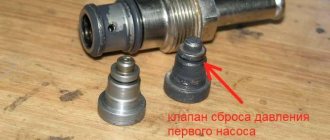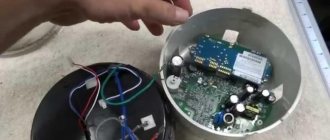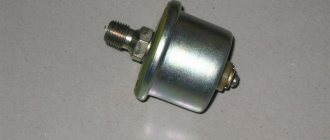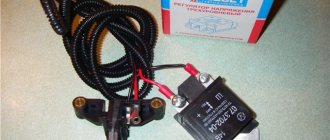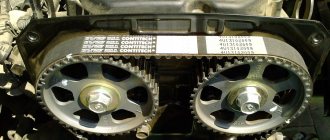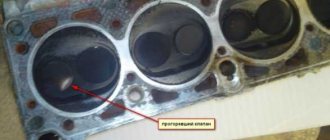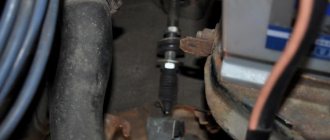The braking system of a car is an important safety element. Its good condition can save lives in case of road accidents. One of the most peculiar components is the rear brake pressure regulator, colloquially known as the sorcerer.
This name appeared with the first Zhiguli cars because of its mystery and unknown operating principle.The VAZ 2110 sorcerer has a catalog number starting with 2108, and is used, in addition to the tenth family, on other VAZ cars: Samara, Kalina and Priora.
Examination
Symptoms of a sorcerer malfunction on a VAZ 2110 appear when braking:
Pulling the car to the side; Skidding; Insufficient brake performance. The VAZ 2110 has a sorcerer on a bracket under the bottom, slightly to the left, in the area of the rear wheels. It is better to work with it on a lift, overpass or inspection hole. The main defects are easily detected during external inspection. Brake fluid leaks indicate wear or damage to the seals.
If the sorcerer's piston has turned sour and does not move, then this is also determined visually when the assistant smoothly presses the brake pedal several times. In both cases, repair is impractical and replacement is necessary.
Everything is in order if the regulator is clean, the gap between the drive lever and the plate is 2 mm, the rod moves when the pedal is pressed.
A working sorcerer must ensure:
Uniformity of braking forces on the rear wheels; Rear brakes engage later than front brakes; Adjustment of this delay, depending on the vehicle load.
Removal and installation
To replace the sorcerer on a VAZ 2110, you need wrenches 13 and 10. Instead of 10, a special wrench for brake fittings is very desirable; it is more gentle than a regular open-end wrench when handling soft copper nuts due to the large contact area.
This type of wrench is similar to a socket wrench, but has a slot for inserting a tube into it and high jaws.
You need about half a liter of brake fluid and 4 rubber plugs for the brake hoses. AvtoVAZ cast iron and Belarusian aluminum regulators are sold in VAZ spare parts stores. Russian VIS is usually more reliable, Belarusian Fenox is lighter and cheaper. The conditions under the bottom are unfavorable for the sorcerer, so you first need to clean the dirt with a stiff brush and moisten the threaded connections with a penetrating lubricant such as WD-40. The fixing bracket is removed from the rear beam; if necessary, you can use a powerful screwdriver to loosen it. The brake pipes are carefully unscrewed, marked for reassembly, and closed with rubber plugs. To dismantle the regulator, it is more convenient to unscrew the two nuts securing the bracket to the bottom and remove the sorcerer assembly. During installation, the regulator fastening bolts (attention, the front bolt is longer than the rear), through elongated holes, are not fully tightened to the bracket to ensure movement during adjustment. Assembly is carried out in the reverse order; for reliability, the clamp-clamp on the beam must be crimped with pliers. To remove air from the system, it is necessary to bleed the brakes after work.
It’s easier to do this together, the process has been described many times, including for the VAZ 2110-2112. When replacing the sorcerer, it is enough to bleed only the rear brakes. Adjustment
The work of the sorcerer on VAZ cars depends on the position of the body. Therefore, adjustment must be performed not only during each maintenance, but also when replacing shock absorbers and springs, after repairing the rear beam and, of course, replacing the sorcerer itself. The car is placed on an overpass or inspection hole, to install the suspension in an equilibrium position, it swings a couple of times hands trunk. Use a 13mm wrench to loosen the fastening bolts to the bracket; the front bolt is not visible from below, you need to find it by touch.
Checking the brake pressure regulator for souring:
Have a helper press the brake pedal while you watch the pressure regulator rod (1), which should extend from the regulator body and act on the spring plate (2), pressing it against the drive lever (3). If the following sequence of operation occurs when you press the pedal, then all that remains is to adjust the “sorcerer”. It is advisable to check the adjustment of the sorcerer during each technical inspection, as well as during the replacement of springs and struts, and repair work on the rear beam.
Brake force regulator - description and replacement
What is the "Sorcerer" for? This is a rather mysterious detail and no one has found a clear answer to this question. Perhaps this is why he was colloquially called a “sorcerer”, because he works magically.
At its core, this part performs a similar function to the anti-lock braking system, preventing the wheels of the rear axle from locking during emergency braking.
Its operation directly depends on the position of the rear axle relative to the car body: when braking sharply, the car nose-dives, and the rear part of the body rises, after which the “witchcraft” begins - the brake force regulator partially blocks the flow of fluid, and the rear wheels do not lock.
Of course, in ideal conditions (dry asphalt, straight road, working brake system and chassis), the brake force regulator does its job perfectly. But such conditions do not always occur.
Device Description
The design and principle of operation of this element are quite simple. At the moment when the rear part of the car body rises and the distance between the axle and the body increases, a special lever is activated, which is connected in a “sorcerer”. This lever lowers the piston, which closes the brake fluid channel, and accordingly the pressure on the rear pads decreases. The wheels do not stop rotating and, accordingly, do not skid.
The idea itself is quite clever, but, as often happens, in practice it raises doubts. After all, if when braking the brake pedal is pressed with great force, then the front wheels go into skid and the car still begins to skid. Quite often, when observing a traffic accident, you will notice that the cars with the “sorcerer” are turned backwards. Is this related to this miracle detail, which in its essence should prevent this skidding?
Signs of a malfunctioning brake force regulator
“Sorcerer”, as an element of the braking system, has a number of signs of malfunction that manifest themselves during emergency braking. Let's look at the first symptoms that call for checking the regulator:
- When braking hard, the car pulls to the side.
- Reduced braking efficiency (feels).
- “Bouncing” and jerking of the car when braking.
In such cases, it is necessary to check not only the “sorcerer”, but also other components of the brake system and chassis. But, since we are talking about the brake force regulator on the VAZ, we will consider this particular mechanism. After placing the car on a lift, pay attention to the regulator. The most common sign of its malfunction is the presence of brake fluid leaks. In case of any malfunction, the best solution is to replace the sorcerer. But, if you still decide to repair the brake force regulator, then below we have prepared brief instructions for this action.
Sorcerer repair
In order to repair the brake force regulator, you need to perform a number of actions:
- Dismantling. We remove the entire assembly, using wrenches 10 and 13. The brake pipes are unscrewed, the brake fluid is drained and plugs are installed in the pipes. Next, the “sorcerer” body is removed, which is attached to the bottom with two nuts.
- Diagnostics and replacement of “sorcerer” parts. Carefully examine the surface of the “Sorcerer”. If necessary, replace faulty parts (sealing rubber bands) using a repair kit. A soured piston cannot be repaired and requires a complete replacement of the unit.
- Installation of the sorcerer. Reassemble and adjust the part in reverse order and bleed the brake system. Add brake fluid.
Repairing this unit is a rather dubious decision. Therefore, we strongly recommend that in case of any malfunction, you perform such an action as replacing the brake force regulator.
Adjusting the braking forces of Lada Vesta
The operating principle of the system that regulates and distributes brake fluid pressure on Lada Vesta cars is fundamentally different from previous models, and there is no “witchcraft” in it. The Lada Vesta brake pressure regulator is directly connected to the ABS system and is electronically regulated depending on the speed of each wheel.
The ABS control unit transmits signals from speed sensors and analyzes the situation. The system “understands” any skidding and allows you to distribute the braking force with maximum efficiency. The pressure is controlled by the valves in the ABS hydraulic block, and there is no need for any magic. In addition, the electronics itself detects all malfunctions and reports them to the driver using a special lamp on the dashboard.
Loading…
Source: https://olade.ru/regulyator-tormoznyx-sil-opisanie-i-zamena
Signs of a working brake pressure regulator
A working regulator (3) should show no signs of brake fluid leakage, the rod should be movable, and the gap between the drive lever and the plate should be 2 mm.
Malfunctioning Sorcerer
If you find that the gap between the lever and the plate (3) does not match or the sorcerer is immobile, you should replace or adjust it.
Necessary tool
Necessary tool
The tool that will be required to carry out the process of adjusting the installed valves in a Lada Granta car. The very first thing is a special set of washers for adjustment. These washers can usually be purchased in thicknesses of 3-4.5 mm, with intervals of 0.05 mm.
In addition, the vehicle owner must have a special device for performing the adjustment process, which is reliable and can significantly save time. Also, take tweezers that have a clamp and a 17 key.
Replacing the sorcerer with a VAZ 2114 tee
Among some car enthusiasts, such a technical procedure as replacing the standard brake force regulator with a so-called tee is popular. The reasons for this replacement are constant complaints from car owners about problems with the sorcerer, for example: - Initially incorrect operation of the new product; - For souring of the element. As a result, failure or improper operation of the braking system; - Other problems.
In other words, driving with a faulty sorcerer is fraught with consequences in the form of skidding, which at high speeds can lead to serious accidents and overturning of the car. Conversely, driving without a brake force regulator is safer (compared to a faulty regulator) due to the fact that only two front wheels are involved in braking, the rear wheels are not blocked at all.
Some car owners simply get rid of the sorcerer. In this case, only the front wheels are used for braking. Other car enthusiasts install a tee instead of the sorcerer VAZ 2114. The tee ensures simultaneous blocking and, accordingly, uniform distribution of braking forces between four wheels. This approach has its pros and cons.
Here's the diagram
Disadvantages of using a tee: — Uncomfortable and dangerous braking in winter conditions (icy conditions); — Possibility of skidding (in cases where the rear wheels lock faster than the front wheels).
Pros: — Sharper and more responsive brakes; — Lower cost of the part; — Increased service life.
Both cars and trucks consist of many components. One important component is the brake force regulator. Not all motorists know how this element works and works. But if it is faulty, an unpleasant surprise may occur for the driver during emergency braking. Car owners call this component of the braking system the “sorcerer”. This node received this name because its work was very mysterious and unpredictable. Let's try to understand the structure, operating principle and adjustment of this regulator.
The purpose of the sorcerer
Where is the oil pressure sensor on the Kamaz
? The so-called sorcerer on the VAZ-2109 is necessary to automatically change the fluid pressure in the rear brake cylinders depending on the load acting on the car when the speed decreases. This element is used in both hydraulic and pneumatic drive systems.
The main purpose of changing the pressure is to prevent possible wheel locking and skidding of the rear axle of the car.
In some car models, in order to maintain their controllability and stability, a regulator is additionally installed in the brake drive of the front wheels.
In addition, on the VAZ-2109 the sorcerer is used to increase the braking efficiency of an empty car. The traction force of a loaded car and an empty one is different, so the force on different axles must be adjusted. In the case of a loaded and empty machine, static type regulators are used. Automatic solutions are installed in trucks.
In sports cars, manufacturers often install a screw adjuster. It is located inside the car and adjusts the balance of the brake system directly during the race. It is adjusted based on weather conditions, road conditions, and tire quality.
Handbrake
It is also necessary to adjust the manual parking brake system. If its functionality is incorrect, the brake pads may jam. It should be adjusted after 30,000 km of vehicle operation or at the first signs of poor quality work. To adjust you will need:
- garage room with inspection hole,
- regular set of keys.
Let's get started:
- Engage forward gear.
- Place stands under the front wheels for safety.
- The rear suspension of the car must be jacked up and supported with reliable supports.
You need to start by checking the lever, which is located inside the car between the two front passenger seats. Raise it two or three clicks. When lifting, one click is made, which means it is tightened. This causes the rear drums to become blocked by the brake pads. If more than 8 are produced, then the cable is weakened and the handbrake does not work:
- With the handbrake on, go down into the inspection hole.
- Loosen the first lock nut on the equalizer.
- Tighten the second nut so that the cable is in a taut position.
- If necessary, on the contrary, release it.
- Check the operation of the lever. It should respond with two or three clicks.
Then tighten the first nut from the hole, tighten with two wrenches to get the effect of tightening two nuts:
- After this, turn off the parking system.
- Check the rotation of the rear wheel rims.
Make rotational movements with your hands. Their rotation should take place without a jerk, calmly scrolling along the axis of the car. The sound should come out rustling. Consequently, the adjustment of the vehicle's brake system was carried out successfully. The vehicle is ready for continued operation. The brakes can also be adjusted in a car workshop. You can entrust this work to specialists. But the motorist experiences reliability when this work is done independently. A car can be considered technically serviceable when it is independently inspected and repaired. He will never let you down in difficult, dangerous times. In addition, the price of repairs at service stations can be high. When doing the work yourself, you need to carefully watch the video. You also need to study the photos and, if necessary, take them to the repair site. Place it on a rack or in the back seat of the car. If necessary, review them again. Read the instructions for the operation and the location of the necessary structures. Finish the adjustment and check the work done on a free asphalt area.
A brake force regulator, or sorcerer in common parlance, is a mechanical device designed to relieve excess pressure in the rear drum brakes.
On VAZ-2109, VAZ-2108, VAZ-2114 and other front-wheel drive models produced in Togliatti, it was installed in the rear left part of the body, under the bottom, in front of the rear suspension beam. The brake pressure regulator on the VAZ-2107 model and other “classics” is located on the right in the direction of travel of the car.
New vehicles equipped with ABS and EBD do not use the sorcerer.
